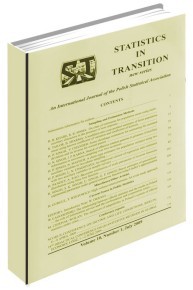Predicting parity progression ratios for young women by the end of their childbearing life
Predicting parity progression ratios for young women by the end of their childbearing life
Author(s): Agnieszka Rossa, Agnieszka PalmaSubject(s): Business Economy / Management
Published by: Główny Urząd Statystyczny
Keywords: fertility rates; parity; projected parity progression ratios
Summary/Abstract: Parity progression ratios (PPR’s) have been extensively described in literature on demography and have played an important role in fertility, unlike the idea of calculating projected parity progression ratios proposed by Brass (1985). However, we decided to use this method in our paper to analyse future fertility trends, firstly by assessing age-specific parity progression ratios for women in childbearing ages, and then by comparing these ratios with ratios at the end of women’s reproductive life, as well as by comparing the latter with the completed PPR’s. More specifically, the aim of this study is to adopt a modified Brass method to calculate the projected parity progression ratios using the age-period fertility data sourced from the Human Fertility Database (HFD). We progress to use the observed and predicted age-specific PPR’s to examine parity progressions in Poland as a case study.
Journal: Statistics in Transition. New Series
- Issue Year: 21/2020
- Issue No: 1
- Page Range: 55-71
- Page Count: 17
- Language: English

